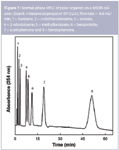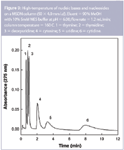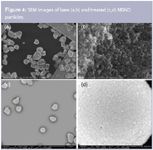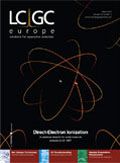Diamonds are a Chromatographer's Best Friend?
LCGC Europe
Pavel Nesterenko from ACROSS about his work on the potential of diamond-related substances as stationary phases
When did you start investigating diamond as a stationary phase — and why?
Our group started investigating diamond as a potential stationary phase for chromatography in 2005, following a discussion about the possibility of fractionating such abrasive microparticles based on size. I was surprised by the amount of different types of synthetic diamonds that have been manufactured by large-scale industrial production and their easy availability.

Pavel Nesterenko
Importantly, at this time, Prof. Georgii Lisichkin and Dr Inna Kulakova from the Laboratory of Organic Catalysis of Lomonosov Moscow State University started their project on chemical modification of diamond surfaces. At the beginning our research was motivated by a simple curiosity to test a new exotic material as our group had previous experience of using non-traditional adsorbents in HPLC, including micro-flakes of copper, hyper-crosslinked polystyrene and porous glassy carbon monoliths.
What unique properties do diamond stationary phases possess and what obstacles could this help them overcome compared with traditional phases?
Every chemist knows about the chemical inertness and hardness of diamond. Less is known about other intriguing properties of diamonds, such as an extremely low thermal expansion coefficient and a very high thermal conductivity (see Table 1). For example, the thermal conductivity of diamond is almost 150 times higher than stainless steel SS316 and thermal expansion is 240 times lower. The combination of these two superior properties with an excellent chemical stability in various aggressive liquids potentially makes diamond an ideal stationary phase for HPLC at elevated temperatures.

Table 1: Physicochemical properties of some materials (as nonporous, 25 °C)
The most popular carbonaceous stationary phase in HPLC is porous graphitic carbon (PGC), which was developed more than 20 years ago and later produced under the trade name Hypercarb. The unique selectivity of PGC towards polar organic compounds is mainly due to the so-called "polar retention effect on graphite" or PREG.1,2 This effect is attributed to the orbital overlap between conductivity electrons in PGC and a lone pair of electrons or π-system in analytes. Diamond, another allotropic form of carbon in sp3 configuration, has significantly higher resistivity than graphite. So, one can expect some difference between adsorption properties of conducting graphite and non-conducting diamond stationary phases. However, doping of the diamond with boron atoms dramatically improves the electrical conductivity, so, potentially, diamond can be a useful alternative because of its favourable mechanical stability. There are also some indications in the literature showing interesting selectivity of diamond to various types of biomolecules.3,4 Taking into account the excellent biocompatibility of diamonds this could be an interesting area of investigation.
Would the cost of diamond make such stationary phases too expensive for routine analysis?
Actually, the first application of diamonds was in HPLC in 1973 and was performed with the relatively big chromatographic column: 25 cm length and 3 mm i.d. packed with 10 micron microparticles of natural diamond.5 A simple calculation using actual and dead volumes of a chromatographic column packed with nonporous particles, with a density of 3.51 g/cm3 for diamond from Table 1, shows that the column content was equal to roughly 20 carats! Actually, natural diamonds are not suitable as a stationary phase because they are not chemically pure and may have different structural defects in the particles, so at present researchers use only synthetic diamonds for the research.
Obviously, there are currently no commercially available diamond phases used in chromatography or in solid-phase extraction (SPE). But, there is large-scale production of various microparticulated diamonds for the preparation of abrasive materials and polishing compositions, so the actual cost of these technical grade diamonds is at the same level, or less, than the same-sized bare silica particles for HPLC.
In our research, we use microdisperse sintered detonation nanodiamonds (MSDN). The name of this material reflects the preparation steps: dynamic synthesis of detonation nanodiamonds by blasting explosives in oxygen-deficient conditions, followed by purification and isolation of the nanodiamonds fraction from the reaction soot, sintering of the aggregates of size 25–35 micron and, finally, crushing and fractionation of size. The current cost of MSND is approximately 10 USD per gramme.
What is the most significant breakthrough you have made in this research?
There are two main obstacles to the wide introduction of diamond-based stationary phases for chromatography. Very poor separation efficiency was always one of them. However, we have achieved a maximum separation efficiency of 43600 theoretical plates per metre for the separation of substituted benzenes on a 150 × 4.0 mm i.d. column packed with 4–5 micron MSDN particles in normal-phase chromatography mode (Figure 1). It is not a lot when compared with the efficiency of current HPLC columns, but it is almost 20–30 times higher than values reported previously for diamond-based stationary phases.

Figure 1
Another problem is the lack of data on the adsorption properties of detonation nanodiamond and their surface chemistry, so it is difficult to identify the areas of possible applications of MSND. Because of harsh conditions during synthesis and purification, more than 20 different functional groups can be simultaneously identified on the surface of MSND. The surface chemistry of nanodiamond can also be different from different producers. Recently we finished an important study on the characterization of the adsorption properties of MSND by mapping the retention of alkylbenzenes and comparing with other common adsorbents, including silica, alumina and PGC (Figure 2). The ion-exchange properties of MSND and its ability to retain polar organic substances have also been investigated. Thus we, probably, removed these obstacles and this achievement will now hopefully open up this area further.

Figure 2
The other important aspect of our results is the demonstration of the applicability of standard size stainless-steel columns with an internal diameter of 4 mm, packed with diamond for chromatographic separations at 160–180 °C (Figure 3) and relatively high flow rate of 1.2 mL/min.
Surprisingly, we did not notice any chromatographic peaks distortions and achieved a 5-fold improvement in separation efficiency compared with separations performed at 60 °C. Obviously, it illustrates the excellent heat dissipation within the relatively bulky diamond column bed.

Figure 3
Which applications could they be useful in?
In terms of exploiting separation selectivity, bare MSNDs are very versatile and can be used in several different chromatographic modes, such as ion-exchange, normal-phase, reversed-phase and affinity chromatography. SEM images of bare (a,b) and treated (c,d) MSND particles are shown in Figure 4.

Figure 4
The electroconducting boron-doped diamond phase has been used for electromodulated chromatography. So, the list of analytes could be quite broad. Considering the advantageous physicochemical properties, diamond-based stationary phases should be extremely useful for HPLC separations at high-pressures and high-temperatures.
Is this research close to being suitable for commercialization?
Obviously, MSDN is not ready for commercialization as a chromatographic packing at the moment. The technology of the production of diamond-related materials, having developed surface area and uniform porous structure, needs further improvement. It should be noted that all of our chromatographic results have been obtained with carefully fractionated and purified materials, which are designed for polishing optics. Obviously, the producers of these abrasives have very different goals and are less worried about some of the parameters that are more important for chromatographers, such as the spherical shape of the particles, pore size and pore volume, and the chemical homogeneity of the surface. The preparation of MSND with optimized characteristics should provide better separation efficiency and well-defined selectivity.
What areas do you intend to explore in the near future?
There is a growing interest in developing new types of diamond-based stationary phase. Actually, the chemical modification of separation selectivity is an obvious future direction because it opens up the possibility of obtaining chemically homogeneous surfaces and/or changing separation selectivity for some specific applications. The other option is to use nanodiamond particles as a material for coating other substrates, similarly to agglomerated ion-exchangers. This work is in progress in collaboration with research groups from within the Irish Separation Science Cluster (ISSC).
Pavel N. Nesterenko obtained a PhD (1982) and DSc (1999) in analytical chemistry from Lomonosov Moscow State University, Russia, where he performed most of his research. In December 2006 he joined the Australian Centre for Research on Separation Science (ACROSS) of University of Tasmania, Hobart, Australia as Professor in Separation Sciences. Professor Nesterenko has published over 220 scientific papers. He is also a member of Editorial boards of Analytica Chimica Acta and Encyclopedia of Analytical Chemistry/Academic Press.
References
T. Cserháti, Biomed. Chromatogr., 23, 111–118 (2009).
L.Pereira, J. Liq. Chrom. Rel. Technol., 31, 687–1731 (2008).
P.N. Nesterenko and P.R. Haddad, Anal. Bioanal. Chem., 396, 205–211 (2010).
K.V. Purtov, A.P. Puzyr and V.S. Bondar, Dokl. Biochem. Biophys., 419, 72–74 (2008).
J. Telepchak, Chromatographia, 6, 234–236 (1973).


.png&w=3840&q=75)

.png&w=3840&q=75)



.png&w=3840&q=75)



.png&w=3840&q=75)














